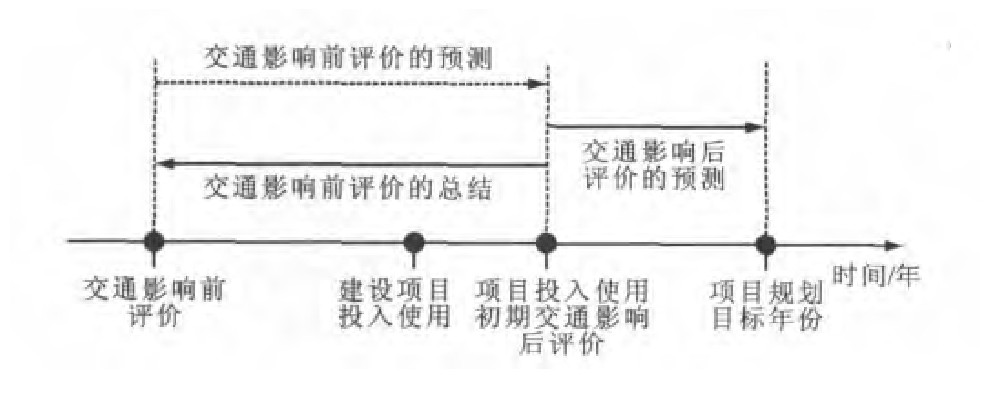Traffic impact post-evaluation model of urban construction project
-
摘要: 基于后评价原理、建立了城市建设项目交通影响后评价模型, 采用权重判断法筛选评价指标, 根据单准则AHP构权法确定各指标权重, 通过计算偏差率, 将各指标归一化。在确定的三级评价指标体系中, 一级指标分别为交通需求预测后评价指标、交通改善措施后评价指标、交通可持续性后评价指标; 二级指标分别为背景交通需求预测指标、项目交通需求预测指标、区域交通需求预测指标、公共交通需求预测指标、静态交通需求预测指标、土地利用改善指标、交通组织改善措施指标、交通适应性指标、经济影响指标、环境影响指标与社会影响指标。评价结果表明: 成都市博远花园住宅项目后评价最大隶属度为0.527 7, 评价等级为部分成功, 评价结果符合实际。可见, 评价指标和模型有效。Abstract: Based on the post-evaluation principle, a traffic impact post-evaluation(TIPE) model of urban construction project was set up, its indexes were selected by using the method of weight judgment.The weight of each index was determined by using the frame weight method of single criterion AHP, and each index was normalized by calculating deviation rate.In the three-grade evaluation index system of TIPE, the first-grade indexes are traffic demand prediction post-evaluation index, traffic improvement measure post-evaluation index and traffic sustainability post-evaluation index respectively.The second-grade indexes are background traffic demand prediction index, project traffic demand prediction index, regional traffic demand prediction index, public transportation demand prediction index, static traffic demand prediction index, land use improvement index, improvement measure index of traffic organization, traffic adaptability index, economic impact index, environmental impact index and social impact index respectively.The TIPE result of Boyuan Garden in Chengdu City indicates that the maximal membership degree is 0.527 7, the evaluation grade is partly successful, and the result is practical.So, the evaluation index system and model are effective.
-
表 1 后评价指标
Table 1. Post-evaluation indexes

表 2 主要道路特征
Table 2. Characteristics of main roads

表 3 三级指标偏差率
Table 3. Reviation rates of third-grade indexes

表 4 三级模糊综合评价结果
Table 4. Result of third-grade fuzzy comprehensive evaluation

表 5 二级模糊综合评价结果
Table 5. Result of second-grade fuzzy comprehensive evaluation

-
[1] WAGNER T. Regional traffic impacts of logistics-related land use[J]. Transport Policy, 2010, 17(4): 224-229. doi: 10.1016/j.tranpol.2010.01.012 [2] NANNI A, BRUSASCA G, CALORI G, et al. Integrated assessment of traffic impact in an alpine region[J]. Science of the Total Environment, 2004, 50(4): 465-471. [3] 王根成, 刘小明. 城市区域交通影响评价定位与方法[J]. 北京工业大学学报, 2008, 34(8): 861-864. https://www.cnki.com.cn/Article/CJFDTOTAL-BJGD200808016.htmWANG Gen-cheng, LIU Xiao-ming. Orientation and meth-odology for the regional traffic impact analysis[J]. Journal of Beijing University of Technology, 2008, 34(8): 861-864. (in Chinese). https://www.cnki.com.cn/Article/CJFDTOTAL-BJGD200808016.htm [4] CHEN Yan-ling, DU Hua-bing. Relationship between traffic impact analysis and city construction—a case study in Beijing[J]. Journal of Transportation Systems Engineering and Information Technology, 2009, 9(6): 21-25. doi: 10.1016/S1570-6672(08)60085-9 [5] 耿化民, 蒋阳升, 钟永艳. 城市规划中微型中央商务区的交通影响分析——以成都市珠江新城为例[J]. 西南交通大学学报, 2009, 44(4): 609-614. doi: 10.3969/j.issn.0258-2724.2009.04.025GENG Hua-min, JIANG Yang-sheng, ZHONG Yong-yan. Traffic impact analysis of MCBD in urban planning case research on Pearl River New Town in Chengdu[J]. Journal of Southwest Jiaotong University, 2009, 44(4): 609-614. (in Chinese). doi: 10.3969/j.issn.0258-2724.2009.04.025 [6] 王晓宁, 盛洪飞, 孟祥海. 基于物元分析的交通影响评价模型[J]. 公路交通科技, 2007, 24(3): 102-106. doi: 10.3969/j.issn.1002-0268.2007.03.024WANG Xiao-ning, SHENG Hong-fei, MENG Xiang-hai. Traffic impact evaluation model based on matter-element analysis[J]. Journal of Highway and Transportation Research and Development, 2007, 24(3): 102-106. (in Chinese). doi: 10.3969/j.issn.1002-0268.2007.03.024 [7] 盖春英. 我国交通影响分析现状及发展建议[J]. 公路交通科技, 2009, 26(8): 115-119, 148. doi: 10.3969/j.issn.1002-0268.2009.08.023GAI Chun-ying. Present state and suggestion of traffic impact analysis of China[J]. Journal of Highway and Transportation Research and Development, 2009, 26(8): 115-119, 148. (in Chinese). doi: 10.3969/j.issn.1002-0268.2009.08.023 [8] 王元庆, 李卫东, 周伟. 城市发展建设中的交通影响管理研究[J]. 城市交通, 2003, 1(1): 19-22. doi: 10.3969/j.issn.1672-5328.2003.01.005WANG Yuan-qing, LI Wei-dong, ZHOU Wei. Research on traffic impact management in urban development and construction[J]. Urban Transport of China, 2003, 1(1): 19-22. (in Chinese). doi: 10.3969/j.issn.1672-5328.2003.01.005 [9] 杨忠振, 王璐, 陈刚. 交通影响评价中的交通区分割方法研究[J]. 公路交通科技, 2007, 24(6): 102-106. doi: 10.3969/j.issn.1002-0268.2007.06.023YANG Zhong-zhen, WANG Lu, CHEN Gang. Method of traffic analysis zone partition for traffic impact evaluation[J]. Journal of Highway and Transportation Research and Development, 2007, 24(6): 102-106. (in Chinese). doi: 10.3969/j.issn.1002-0268.2007.06.023 [10] 王书灵, 王方, 邱荣华. 基于微观交通仿真的交通影响评价研究[J]. 交通运输系统工程与信息, 2009, 9(6): 81-86. doi: 10.3969/j.issn.1009-6744.2009.06.013WANG Shu-ling, WANG Fang, QIU Rong-hua. Traffic impact analysis using microscopic traffic simulation model[J]. Journal of Transportation Systems Engineering and Information Technology, 2009, 9(6): 81-86. (in Chinese). doi: 10.3969/j.issn.1009-6744.2009.06.013 [11] 陆建, 崔洪军, 潘建芳. 大型活动交通研究范围确定方法[J]. 武汉理工大学学报: 交通科学与工程版, 2009, 33(3): 422-425. doi: 10.3963/j.issn.1006-2823.2009.03.005LU Jian, CUI Hong-jun, PAN Jian-fang. Traffic research area delimitating method of large activities[J]. Journal of Wuhan University of Technology: Transportation Science and Engineering, 2009, 33(3): 422-425. (in Chinese). doi: 10.3963/j.issn.1006-2823.2009.03.005 [12] 李德刚, 霍娅敏, 罗霞. 公路主枢纽总体布局规划后评价研究[J]. 中国公路学报, 2005, 18(2): 84-89. doi: 10.3321/j.issn:1001-7372.2005.02.017LI De-gang, HUO Ya-min, LUO Xia. Research on post-evaluation of highway main hub general planning[J]. China Journal of Highway and Transport, 2005, 18(2): 84-89. (in Chinese). doi: 10.3321/j.issn:1001-7372.2005.02.017 [13] 罗党, 贠慧萍, 吴顺祥. 具有方案偏好信息的灰色多属性决策方法[J]. 厦门大学学报: 自然科学版, 2008, 47(3): 323-327. doi: 10.3321/j.issn:0438-0479.2008.03.005LUO Dang, YUN Hui-ping, WU Shun-xiang. Uncertain multi-attribute decision making method with alternative scheme preference information[J]. Journal of Xiamen University: Natural Science, 2008, 47(3): 323-327. (in Chinese). doi: 10.3321/j.issn:0438-0479.2008.03.005 [14] 于永海, 王延章, 索安宁, 等. 基于模糊综合评价的基本功能岸段划分方法研究[J]. 大连理工大学学报, 2011, 51(5): 447-452. https://www.cnki.com.cn/Article/CJFDTOTAL-DLLG201103024.htmYU Yong-hai, WANG Yan-zhang, SUO An-ning. Research on division method for basic function coastline based on fuzzy synthetic evaluation[J]. Journal of Dalian University of Technology, 2011, 51(5): 447-452. (in Chinese). https://www.cnki.com.cn/Article/CJFDTOTAL-DLLG201103024.htm [15] 向前忠. 公路网规划后评价方法及其应用研究[D]. 西安: 长安大学, 2002.XIANG Qian-zhong. Study on method and application of post-evaluation for highway network planning[D]. Xi'an: Chang'an University, 2002. (in Chinese). [16] 西南交通大学. 成都博远花园住宅项目交通影响评价报告[R]. 成都: 西南交通大学, 2006.Southwest Jiaotong University. The report of traffic impact evaluation of Boyuan Garden housing project[R]. Chengdu: Southwest Jiaotong University, 2006. (in Chinese). [17] 兰继斌, 徐扬, 霍良安, 等. 模糊层次分析法权重研究[J]. 系统工程理论与实践, 2006, 26(9): 107-112. doi: 10.3321/j.issn:1000-6788.2006.09.014LAN Ji-bin, XU Yang, HUO Liang-an, et al. Research on the priorities of fuzzy analytical hierarchy process[J]. Systems Engineering—Theory and Practice, 2006, 26(9): 107-112. (in Chinese). doi: 10.3321/j.issn:1000-6788.2006.09.014 -





 下载:
下载:


